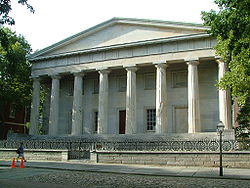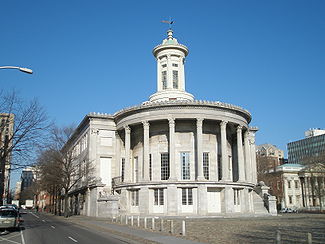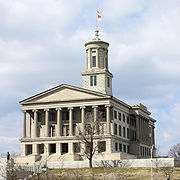.gif)
William Strickland (architect)
Encyclopedia
William Strickland was a noted architect
in nineteenth-century Philadelphia, Pennsylvania
and Nashville, Tennessee
.
Strickland's design for the Second Bank of the United States
in Philadelphia (1819–1824) beat out the design of his teacher, Benjamin Latrobe
. Although Strickland was still copying classical
prototypes at this point, the Second Bank is an ambitious building modeled on the greatest Greek design: The Parthenon
of Athens
. The competition had called for "chaste" Greek style: Strickland's elegant Greek temple
design is a fitting result. The architect clearly saw this building as one of his major accomplishments, as he had it included as the background of the portrait that Philadelphia society painter John Neagle
did of Strickland in 1829 (Yale University Art Gallery
)
 Comparison of the Second Bank of the U.S. with the later Merchants' Exchange
Comparison of the Second Bank of the U.S. with the later Merchants' Exchange
(1832-4), also in Philadelphia, reveals the growth of Strickland's talent and confidence as an architect. With the Merchant Exchange, Strickland still had a classical example in mind (the cupola
is based on the Choragic Monument of Lysicrates
), but created a unique building specifically styled to fit the site. The Merchant's Exchange was to be located on a slightly-awkward triangular plot, at the intersection of two major thoroughfares, between the waterfront and the business district
. The elegant, curved east façade faces toward the waterfront
, and reflects the carriage and foot traffic that would have been circulating in front of the building. This elevation is unique — Greek Revival, but modern — while a more staid and formal elevation can be found on the west side, facing Third Street. This building demonstrates Strickland's maturity as an architect, showing that some of America's architects were truly innovating in the Greek Revival.
 Another of Strickland's buildings was the National Mechanic Bank
Another of Strickland's buildings was the National Mechanic Bank
at 22 South 3rd St. The bank's construction began in 1836 on a narrow plot between two taller neighbors. Strickland took the narrow space, however, and used strong, square pilasters to support the portico as well as ornate stone carving at their tops to defend the building against its taller and bulkier neighbors. The building is one of Strickland's smallest and has since gone through several changes of ownership. The building is now occupied by National Mechanics Bar and Restaurant. It was one of Strickland's last Philadelphia buildings.
Strickland also executed works in other styles, including very early American work in the Gothic Revival style, including his Masonic Hall (1808–11, burned 1819) and his Saint Stephen's Church (1823), both in Philadelphia. He also made use of Egyptian, Saracenic and Italianate styles. He later moved to Nashville, Tennessee, where his Egyptian
-influenced design of the First Presbyterian Church (now the Downtown Presbyterian Church) was controversial but today is widely recognized as a masterpiece and an important evocation of the Egyptian Revival style.
Strickland was also a civil engineer
and one of the first to advocate the use of steam locomotives on railways. In his youth he was a landscape painter, illustrator for periodicals, theatrical scene painter, engraver, and pioneer aquatint
ist. William Levitt (Early Railways 3, 2006) argues that Strickland's observations made during visits to England in the 1820s were highly influential in the transfer of railway technology to the United States.
Strickland is buried within the walls of his final, and arguably greatest work, the Tennessee State Capitol
.

Architecture
Architecture is both the process and product of planning, designing and construction. Architectural works, in the material form of buildings, are often perceived as cultural and political symbols and as works of art...
in nineteenth-century Philadelphia, Pennsylvania
Philadelphia, Pennsylvania
Philadelphia is the largest city in the Commonwealth of Pennsylvania and the county seat of Philadelphia County, with which it is coterminous. The city is located in the Northeastern United States along the Delaware and Schuylkill rivers. It is the fifth-most-populous city in the United States,...
and Nashville, Tennessee
Nashville, Tennessee
Nashville is the capital of the U.S. state of Tennessee and the county seat of Davidson County. It is located on the Cumberland River in Davidson County, in the north-central part of the state. The city is a center for the health care, publishing, banking and transportation industries, and is home...
.
Life and career
Strickland was one of the founders of the Greek Revival movement in the United States, using the plates of The Antiquities of Athens for his inspiration.Strickland's design for the Second Bank of the United States
Second Bank of the United States
The Second Bank of the United States was chartered in 1816, five years after the First Bank of the United States lost its own charter. The Second Bank of the United States was initially headquartered in Carpenters' Hall, Philadelphia, the same as the First Bank, and had branches throughout the...
in Philadelphia (1819–1824) beat out the design of his teacher, Benjamin Latrobe
Benjamin Latrobe
Benjamin Henry Boneval Latrobe was a British-born American neoclassical architect best known for his design of the United States Capitol, along with his work on the Baltimore Basilica, the first Roman Catholic Cathedral in the United States...
. Although Strickland was still copying classical
Classical antiquity
Classical antiquity is a broad term for a long period of cultural history centered on the Mediterranean Sea, comprising the interlocking civilizations of ancient Greece and ancient Rome, collectively known as the Greco-Roman world...
prototypes at this point, the Second Bank is an ambitious building modeled on the greatest Greek design: The Parthenon
Parthenon
The Parthenon is a temple on the Athenian Acropolis, Greece, dedicated to the Greek goddess Athena, whom the people of Athens considered their virgin patron. Its construction began in 447 BC when the Athenian Empire was at the height of its power. It was completed in 438 BC, although...
of Athens
Athens
Athens , is the capital and largest city of Greece. Athens dominates the Attica region and is one of the world's oldest cities, as its recorded history spans around 3,400 years. Classical Athens was a powerful city-state...
. The competition had called for "chaste" Greek style: Strickland's elegant Greek temple
Temple
A temple is a structure reserved for religious or spiritual activities, such as prayer and sacrifice, or analogous rites. A templum constituted a sacred precinct as defined by a priest, or augur. It has the same root as the word "template," a plan in preparation of the building that was marked out...
design is a fitting result. The architect clearly saw this building as one of his major accomplishments, as he had it included as the background of the portrait that Philadelphia society painter John Neagle
John Neagle
John Neagle was a fashionable American painter, primarily of portraits, during the first half of the 19th century in Philadelphia.-Biography:Neagle was born in Boston, Massachusetts...
did of Strickland in 1829 (Yale University Art Gallery
Yale University Art Gallery
The Yale University Art Gallery houses a significant and encyclopedic collection of art in several buildings on the campus of Yale University in New Haven, Connecticut. Although it embraces all cultures and periods, the Gallery possesses especially renowned collections of early Italian painting,...
)

Merchants' Exchange Building (Philadelphia)
Built between 1832 and 1834, the Merchants' Exchange Building, is located on the triangular site bounded by Dock Street, Third Street, and Walnut Street. This monumental office building, designed by architect William Strickland, operated as a brokerage house in the nineteenth century...
(1832-4), also in Philadelphia, reveals the growth of Strickland's talent and confidence as an architect. With the Merchant Exchange, Strickland still had a classical example in mind (the cupola
Cupola
In architecture, a cupola is a small, most-often dome-like, structure on top of a building. Often used to provide a lookout or to admit light and air, it usually crowns a larger roof or dome....
is based on the Choragic Monument of Lysicrates
Choragic Monument of Lysicrates
The Choragic Monument of Lysicrates near the Acropolis of Athens was erected by the choregos Lysicrates, a wealthy patron of musical performances in the Theater of Dionysus to commemorate the award of first prize in 335/334 BCE, to one of the performances he had sponsored...
), but created a unique building specifically styled to fit the site. The Merchant's Exchange was to be located on a slightly-awkward triangular plot, at the intersection of two major thoroughfares, between the waterfront and the business district
Central business district
A central business district is the commercial and often geographic heart of a city. In North America this part of a city is commonly referred to as "downtown" or "city center"...
. The elegant, curved east façade faces toward the waterfront
Shore
A shore or shoreline is the fringe of land at the edge of a large body of water, such as an ocean, sea, or lake. In Physical Oceanography a shore is the wider fringe that is geologically modified by the action of the body of water past and present, while the beach is at the edge of the shore,...
, and reflects the carriage and foot traffic that would have been circulating in front of the building. This elevation is unique — Greek Revival, but modern — while a more staid and formal elevation can be found on the west side, facing Third Street. This building demonstrates Strickland's maturity as an architect, showing that some of America's architects were truly innovating in the Greek Revival.

Mechanics National Bank
The Mechanics National Bank was a Philadelphia, Pennsylvania, bank founded by and geared toward mechanics.-History:In 1809, Philadelphia was already known for both skilled workers and as America's main financial center, but the merchants who controlled its banks had little interest in lending to...
at 22 South 3rd St. The bank's construction began in 1836 on a narrow plot between two taller neighbors. Strickland took the narrow space, however, and used strong, square pilasters to support the portico as well as ornate stone carving at their tops to defend the building against its taller and bulkier neighbors. The building is one of Strickland's smallest and has since gone through several changes of ownership. The building is now occupied by National Mechanics Bar and Restaurant. It was one of Strickland's last Philadelphia buildings.
Strickland also executed works in other styles, including very early American work in the Gothic Revival style, including his Masonic Hall (1808–11, burned 1819) and his Saint Stephen's Church (1823), both in Philadelphia. He also made use of Egyptian, Saracenic and Italianate styles. He later moved to Nashville, Tennessee, where his Egyptian
Ancient Egypt
Ancient Egypt was an ancient civilization of Northeastern Africa, concentrated along the lower reaches of the Nile River in what is now the modern country of Egypt. Egyptian civilization coalesced around 3150 BC with the political unification of Upper and Lower Egypt under the first pharaoh...
-influenced design of the First Presbyterian Church (now the Downtown Presbyterian Church) was controversial but today is widely recognized as a masterpiece and an important evocation of the Egyptian Revival style.
Strickland was also a civil engineer
Civil engineer
A civil engineer is a person who practices civil engineering; the application of planning, designing, constructing, maintaining, and operating infrastructures while protecting the public and environmental health, as well as improving existing infrastructures that have been neglected.Originally, a...
and one of the first to advocate the use of steam locomotives on railways. In his youth he was a landscape painter, illustrator for periodicals, theatrical scene painter, engraver, and pioneer aquatint
Aquatint
Aquatint is an intaglio printmaking technique, a variant of etching.Intaglio printmaking makes marks on the matrix that are capable of holding ink. The inked plate is passed through a printing press together with a sheet of paper, resulting in a transfer of the ink to the paper...
ist. William Levitt (Early Railways 3, 2006) argues that Strickland's observations made during visits to England in the 1820s were highly influential in the transfer of railway technology to the United States.
Strickland is buried within the walls of his final, and arguably greatest work, the Tennessee State Capitol
Tennessee State Capitol
The Tennessee State Capitol, located in Nashville, Tennessee, is the home of the Tennessee legislature, the location of the governor's office, and a National Historic Landmark. Designed by architect William Strickland, it is one of Nashville's most prominent examples of Greek Revival architecture...
.

Philadelphia buildings
- Masonic Hall, Philadelphia (1808–11, burned 3 March 1819).
- Holy Trinity Romanian Orthodox Church, Philadelphia, also known as the former St. John's Episcopal Church (1815-16).
- Second Bank of the United States]], Philadelphia (1819–24).
- St. Stephen's Episcopal Church, Philadelphia (1822–23).
- Musical Fund Hall, The Musical Fund SocietyThe Musical Fund SocietyThe Musical Fund Society is one of the oldest musical societies in the United States founded in February 1820 by Benjamin Carr, Raynor Taylor, George Schetky and Benjamin Cross, and the painter Thomas Sully...
, Philadelphia (1824, substantially altered). - Second Congregation Mikveh Israel Synagogue, Philadelphia (1825, demolished).
- United States Naval AsylumPhiladelphia Naval AsylumThe Philadelphia Naval Asylum, later the Naval Home, was a hospital, the Philadelphia Naval School, and a home for retired sailors for the United States Navy from 1834 to 1976, located in Philadelphia, Pennsylvania....
, Philadelphia (1826–33, now condominiums). - Restoration of the tower of Independence Hall, Philadelphia (1828).
- First Unitarian Church of PhiladelphiaFirst Unitarian Church of PhiladelphiaThe First Unitarian Church of Philadelphia is a Unitarian Universalist congregation located at 2125 Chestnut Street in Philadelphia, Pennsylvania...
, (1828) - University of Pennsylvania (9th Street buildings), Philadelphia (1829).
- United States Mint, Philadelphia (1829–33, demolished 1902).
- Merchants' ExchangeMerchants' Exchange Building (Philadelphia)Built between 1832 and 1834, the Merchants' Exchange Building, is located on the triangular site bounded by Dock Street, Third Street, and Walnut Street. This monumental office building, designed by architect William Strickland, operated as a brokerage house in the nineteenth century...
, Philadelphia (1832–34).
Buildings elsewhere
- College of CharlestonCollege of CharlestonThe College of Charleston is a public, sea-grant and space-grant university located in historic downtown Charleston, South Carolina, United States...
, Main Building (now Randolph Hall), Charleston, South Carolina (1828, extensively altered 1850). - U.S. Branch Mint, CharlotteCharlotte MintThe Charlotte Mint was a branch of the United States Mint that came into existence on March 3, 1835 during the Carolina Gold Rush. The first gold mine in the United States was established in North Carolina at the Reed Gold Mine...
, North Carolina (1835, moved to new location 1930s). Now Mint Museum of Art. - U.S. Branch Mint, DahlonegaDahlonega MintThe Dahlonega Mint was a branch of the United States Mint. It was located at 34°31.8′N 83°59.2′W at Dahlonega, Lumpkin County, Georgia. Coins produced at the Dahlonega Mint bear the "D" mint mark. That mint mark is used today by the Denver Mint, which opened many years after the Dahlonega Mint...
, Georgia (1835, burned 1878). - U.S. Branch Mint, New OrleansNew Orleans MintThe New Orleans Mint operated in New Orleans, Louisiana, as a branch mint of the United States Mint from 1838 to 1861 and from 1879 to 1909. During its years of operation, it produced over 427 million gold and silver coins of nearly every American denomination, with a total face value of over...
, Louisiana (1835–38). - Providence AthenaeumProvidence AthenaeumThe Providence Athenaeum, founded in 1753 in Providence, Rhode Island, is the fourth oldest subscription library in the United States. Only the Library Company of Philadelphia, founded in 1731 by Benjamin Franklin, Newport's Redwood Library and Athenaeum, founded in 1747, and the Charleston Library...
, Providence, Rhode Island (1837–38). - Grace ChurchGrace Episcopal Church (Keswick, Virginia)Grace Episcopal Church is a historic church located at 5607 Gordonsville Road in Keswick, Virginia, United States. The Gothic Revival building was designed by noted architect William Strickland in 1847...
, Keswick, Virginia (1848–55).
Tennessee
- St. Mary's Catholic Church, Nashville, TennesseeSt. Mary's Catholic Church (Nashville, Tennessee)St. Mary's Catholic Church is a historic church at 330 5th Avenue, N. in Nashville, Tennessee.It was built in 1845 and added to the National Register in 1970....
(1845–47). - Tennessee State CapitolTennessee State CapitolThe Tennessee State Capitol, located in Nashville, Tennessee, is the home of the Tennessee legislature, the location of the governor's office, and a National Historic Landmark. Designed by architect William Strickland, it is one of Nashville's most prominent examples of Greek Revival architecture...
, Nashville, Tennessee (1845–59). - Second Presbyterian Church, Nashville, Tennessee (1846, demolished 1979).
- Wilson County Courthouse, Lebanon, Tennessee (1848, burned 1881).
- First Presbyterian ChurchDowntown Presbyterian Church, NashvilleThe Downtown Presbyterian Church in Nashville, Tennessee, affiliated with Presbyterian Church , was formerly known as First Presbyterian Church. The church is located at the corner of Fifth Avenue and Church Street. As Old First Presbyterian Church it is designated a National Historic...
, Nashville, Tennessee (1848–49). - Belmont MansionBelmont Mansion (Tennessee)Belmont Mansion, also known as Acklen Hall, and originally known as Belle Monte, Belle Mont or Belmont, is a historic mansion located in Nashville, Tennessee on the campus of Belmont University that today functions as a museum....
, Nashville, Tennessee (1849–53). Formerly Acklen Hall during Ward-Belmont College years, Belmont UniversityBelmont UniversityBelmont University is a private, coeducational, liberal arts university located in Nashville, Tennessee, United States. It is the largest Christian university in Tennessee and the second largest private university in the state, behind nearby Vanderbilt University.-Belmont Mansion:Belmont Mansion...
.

